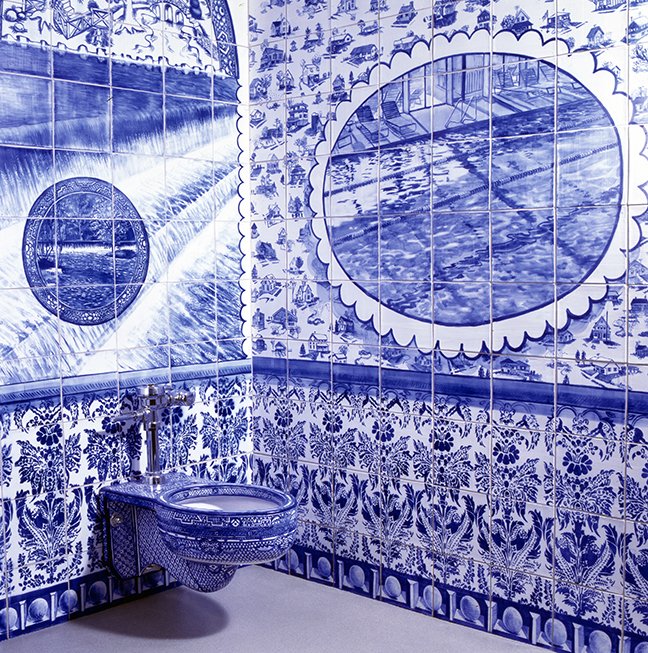Washrooms
In the late 1990s, the John Michael Arts Center commissioned six artists to transform its public washrooms into works of art. Working in Kohler Co.’s Pottery and Foundry under the auspices of the Arts/Industry residency program, the artists designed and created the tiles, plumbingware, and other components comprising these immersive spaces. They also oversaw the installation of their work.
As hybrids of public and private space, of fine art and utilitarian design, these washrooms exemplify the Arts Center’s mission of generating creative exchanges between artists and the public. They also embody the belief that art can enliven, enrich, and inform every facet of life.
The two washrooms located in the Arts Center’s atrium are the work of New York artist Matt Nolen and Massachusetts artist Cynthia Cosentino (another, designed by California artist Yolande Macias McKay, is no longer extant). Brooklyn artist Ann Agee and Philadelphia artist Merrill Mason created the two east wing washrooms. California artist Casey O’Connor collaborated with seventy preschool-age children to design the Children’s Studio washroom. New York artist Carter Kustera created the sixth washroom, located near the Theatre.
The artist-designed washrooms at the Arts Center epitomize the achievements of Arts/Industry—an ongoing, decades-long collaboration between art and industry conceived by former JMKAC Director Ruth DeYoung Kohler II. Launched in 1974 as a means of supporting artistic exploration, Arts/Industry gives artists from around the world the opportunity to create new bodies of work using the facilities, technologies, and materials of Kohler Co.
Casey O'Connor: Childhood Vitreous
Location: Preschool
The washroom in the Children’s Studio was created by and for the children in JMKAC’s Preschool with California artist Casey O’Connor. Childhood Vitreous combines spirited painted tiles in primary colors with O’Connor’s sculptural homage to beloved children’s toys. He perfected a technique of injecting discarded stuffed toy animals with liquid clay. After drying, the stuffed toys are fired. The hardened clay retains the form and textures of the toy animal, while the stuffing and fabric burn away. O’Connor utilized this technique to make sculptures for the niches in the washroom, often joining parts of one toy with parts from another. These sculptures evoke a flood of memories prompted by the worn nap of much-loved teddy bears and crocheted animals. The room, finished with a toddler-scale sink, has a bright blue scalloped seat toilet and hundreds of ceramic tiles glazed by children who attended the Arts Center’s arts-based preschool. Self-portraits and images of family members, pets, suns, and monsters make this a special place for children.
Carter Kustera: Tell Me Something I Don't Already Know
Location: across from Theatre
Carter Kustera’s family washroom, Tell Me Something I Don’t Already Know, is based on information anonymously provided by Arts Center members. Over nine hundred members sent in their first name and a brief sentence about themselves for use in this project. Kustera harvested such gems as, “Vue is living his dreams,” “Marjorie is a 100–year–old fairy tale princess,” “Bob won’t admit that the squirrel has beaten him,” and “Laura paints the world.” Imagining what each person looked like based on the descriptions, Kustera painted hundreds of silhouettes–humorous, serene, and stern–that cover the walls of the room. The counter, carved into the shape of a profile, supports a clear glass lavatory, while the mirror above is etched with an invitation for viewers to: “Tell me something about yourself that I don’t already know.”
Merrill Mason: Filling and Emptying
Location: East Wing
The entrance to Filling and Emptying is flanked by vignettes of cast-iron objects set into marble-lined niches. Merrill Mason collected perfume bottles, lace-edged and embroidered linens, gloves, lipsticks, hand mirrors, and hair combs and re-created them in iron, replacing the tactile qualities of these intimate items with an unyielding permanence appropriate for their public placement. The interior of the washroom furthers the concept of a woman’s private room for dressing, contemplation, and ritualized preparation with additional iron still lifes and photographs of a woman seated at a vanity holding Mason’s sculptures. The tiled walls are embossed with historical French, English, and American monograms, both an abstraction of identity and symbols of propriety. Mason created these tiles as well as lavatories and toilet bowls at the Kohler Co. Pottery. Text in the toilet bowls refers to the flow of water: “filling and emptying” and “swirling, swirling, around and around and down.” Mason’s room offers quiet contemplation of the boundaries between public and private through personal objects and procedures that prepare one for public presentation.
Ann Agee: Sheboygan Men's Room
Location: East Wing
Brooklyn artist Ann Agee was first invited to be an artist-in-residence in the Arts/Industry program in 1991. Trained as a painter at Yale and with an MFA from Cooper Union School of Art, Agee had no formal training in ceramics but began painting on clay through a desire to create three-dimensional paintings. For the washroom commissioned in 1998, Sheboygan Men’s Room, Agee chose to work with rich cobalt blue and white, deliberately reminiscent of Delft and Staffordshire ceramics. She glazed hundreds of tiles, the lavatories, urinal, toilets, and counter with intricate patterns inspired by historical motifs and with imagery devoted to the subject of water, particularly how it touches the lives of Sheboygan-area residents. All of the images in the washroom represent places in Sheboygan County–from a local car wash to views of Lake Michigan, a community swimming pool to supermarket shelves laden with bottled water, a water treatment plant to hundreds of Sheboygan homes with sprinklers and swimming pools.
Cynthia Consentino: The Women's Room
Location: Atrium
Massachusetts artist Cynthia Consentino was selected to create the first new artist-designed washroom for the Arts Center since 1999. The Women’s Room opened to the public in June 2005. Loved at once for its buoyant colors and dazzling hand-painted imagery, The Women’s Room reflects the artist’s own affection and aversion toward what society has defined as female.
Consentino created over thirty sculptural reliefs of female body types, animal figures, objects, accessories, and plants. She then hand painted hundreds of tiles that were created using molds of those reliefs. Consentino arranged the tiles in various combinations to create cohesive bodies—both recognizable female figures and fantastical forms. The figures, which can be read as “pure play,” suggest many of the roles of women in society and include references to fairy tales, myths, and cultural slang.
The Women’s Room also includes over 120 glaze paintings of hats and shoes and hand-painted sinks and toilets. Painted in a colorful, light, and expressive manner, the stall tiles depict a near categorical display of women’s undergarments and accessories including bras, stockings, hair combs, jewelry, and handbags.
Matt Nolen: The Social History Of Architecture
Location: Atrium
New York artist Matt Nolen created a ceiling-to-floor tile mural for the largest of the washrooms. His interpretive The Social History of Architecture is a tour of architectural periods from ancient Egypt to the present. On the longest uninterrupted wall, illustrations of architectural icons progress through the ages, beginning with the modern era and continuing through the art historical periods of Art Nouveau, Victorian, Baroque, Gothic, Medieval, ancient Rome, and ancient Egypt. On the opposite wall, tiles and fixtures portray the hands of rulers or visionaries from each successive period with appropriate symbols of power, from a cell phone to the Pope’s ring. While in the washroom, as you make use of the various fixtures, you can imagine yourself a Pharaoh, Caesar, pontiff, or CEO. This subtle empowerment of the individual is reinforced by a quote by poet, writer, and natural philosopher Johann Wolfgang von Goethe that rings the soaring blue ceiling of the room: “Whatever you can do or dream, you can begin it. Boldness has genius, power, and magic in it.”





